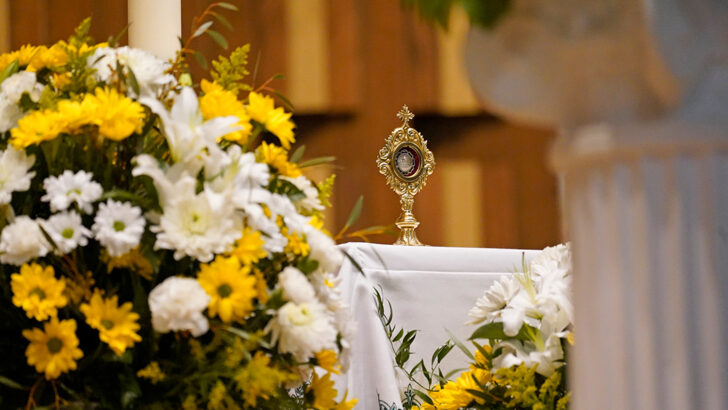Saint Bernadette Special
The relics of the saints are a trusted way to draw closer to God, writes Michael Kelly
Catholic veneration of relics – body parts and indeed objects linked to the lives of holy men and women – goes right back to the early Church. The bodies of the martyrs were often retrieved after their deaths. And their resting places became places of pilgrimage.
As persecution faded and the faith grew, Christians longed to have their own association with the holy men and women who had given their lives for the Faith – soon the practice of distributing relics became common as a way to sanctify places of worship and spread devotion to the saints as a way of encouraging people to emulate their lives of witness.
Generations
Up until a couple of generations ago, every newly-consecrated altar would have relics placed in it as part of the solemn ceremony presided over by the bishop to set aside the space for sacred duties.
Abuses around the time of the Reformation led some people to be sceptical about relics, and the Church is always cautious to discourage any form of superstition or magical thinking around relics. After all, worship is for God – not the saints, however much we might admire their examples of life and want to feel close to them.
Think about it at a purely human level. When a child dies, a parent will often hold their blanket dear – because it helps them feel close to the child they miss so dearly. Items associated with the person who had died, are often very dear to us – this is why heirlooms are so important to families.
Some Catholics feel a bit squeamish about relics – the piety and devotion can be off-putting for some, but that is to fail to see and appreciate that God came to us in human flesh and the human body is made in God’s image and likeness.
The Church refers to the phenomenon as incorruptibility, a belief that divine intervention allows some bodies to completely or partially avoid the normal process of decomposition”
As the relics of St Bernadette come on their tour of Ireland, people from every part of the country are likely to turn out to venerate this holy woman. Faith is a personal thing, and everyone carries their own journey on occasions like this. For some, it will be the earnest hope for a miracle, for others it will be for an increase in a faltering faith, for others still it will be simple thanksgiving for all the good things that come in life. Many others will have no particular idea why they are venerating the relics of Bernadette, but will still feel quietly drawn to that simple act of faith, hope and trust.
St Bernadette’s body remains on display for public veneration today. The Church refers to the phenomenon as incorruptibility, a belief that divine intervention allows some bodies to completely or partially avoid the normal process of decomposition after death as a sign of their holiness.
None of this is to say that the body must remain perfectly intact and free from all decomposition. To be considered extraordinary, a body has to be in an unusually well-preserved state, with lifelike colour and freshness, lack of odour or signs of normal putrefaction, and some degree of flexibility.
Of course, faith does not rise or fall on such phenomenon and Catholics are not required to believe that a body is preserved by divine intervention. There are also other factors, including environmental, that can affect the natural process of decomposition.
Canonisation
At one time, the Church would accept a candidate for sainthood’s incorruptibility as one of the miracles required for canonisation. This practice fell out of use because being incorrupt after death is not one of the requirements to be declared a saint in the Church, nor is it a definitive sign of having lived a life of heroic virtue.
According to Catholic tradition, incorruptible saints give witness to the truth of the resurrection of the body and the life that is to come. But, at the same time most people who are canonised have indeed decayed. There are also examples from history when bodies of saintly people believed to be incorrupt were later shown to have extensively treated and embalmed soon after their deaths.
The fact that God took on human flesh means Christians venerate with great reverence the bodies of those who have gone before us”
In 2020, when the Vatican approved the beatification of the Italian teen Carlo Acutis, internet rumours soon spread when his body was put on display that it was discovered incorrupt. This led the Bishop of Assisi, Italy, Dr Domenico Sorrentino, to clarify that though Blessed Carlo’s body appeared intact in photos, that was due to the use of a silicone reconstruction of his face — his body had been found in a normal state of decay when exhumed 14 years after his death in 2006.
Venerate
Catholicism is an incarnational faith, the fact that God took on human flesh means Christians venerate with great reverence the bodies of those who have gone before us. That’s why sprinkling and incensing of the coffin is an important part of the Catholic funeral rites.
Relics are like a signpost pointing towards Heaven, and a reminder to imitate the life of the holy person being held up as a model.
St Bernadette’s body remains in Nevers, but the visit of her relics to Ireland is a huge opportunity for Irish Catholics to venerate the saint, and through her intercession draw closer to the God who will raise all our mortal bodies.


 Michael Kelly
Michael Kelly A reliquary containing a relic of St Bernadette Soubirous is seen on the altar during a healing Mass in 2022, at Holy Family Church in Queens, New York. The evening service was celebrated in anticipation of the World Day of the Sick, an annual observance that coincides with the February 11 feast of Our Lady of Lourdes. Photo: OSV
A reliquary containing a relic of St Bernadette Soubirous is seen on the altar during a healing Mass in 2022, at Holy Family Church in Queens, New York. The evening service was celebrated in anticipation of the World Day of the Sick, an annual observance that coincides with the February 11 feast of Our Lady of Lourdes. Photo: OSV 